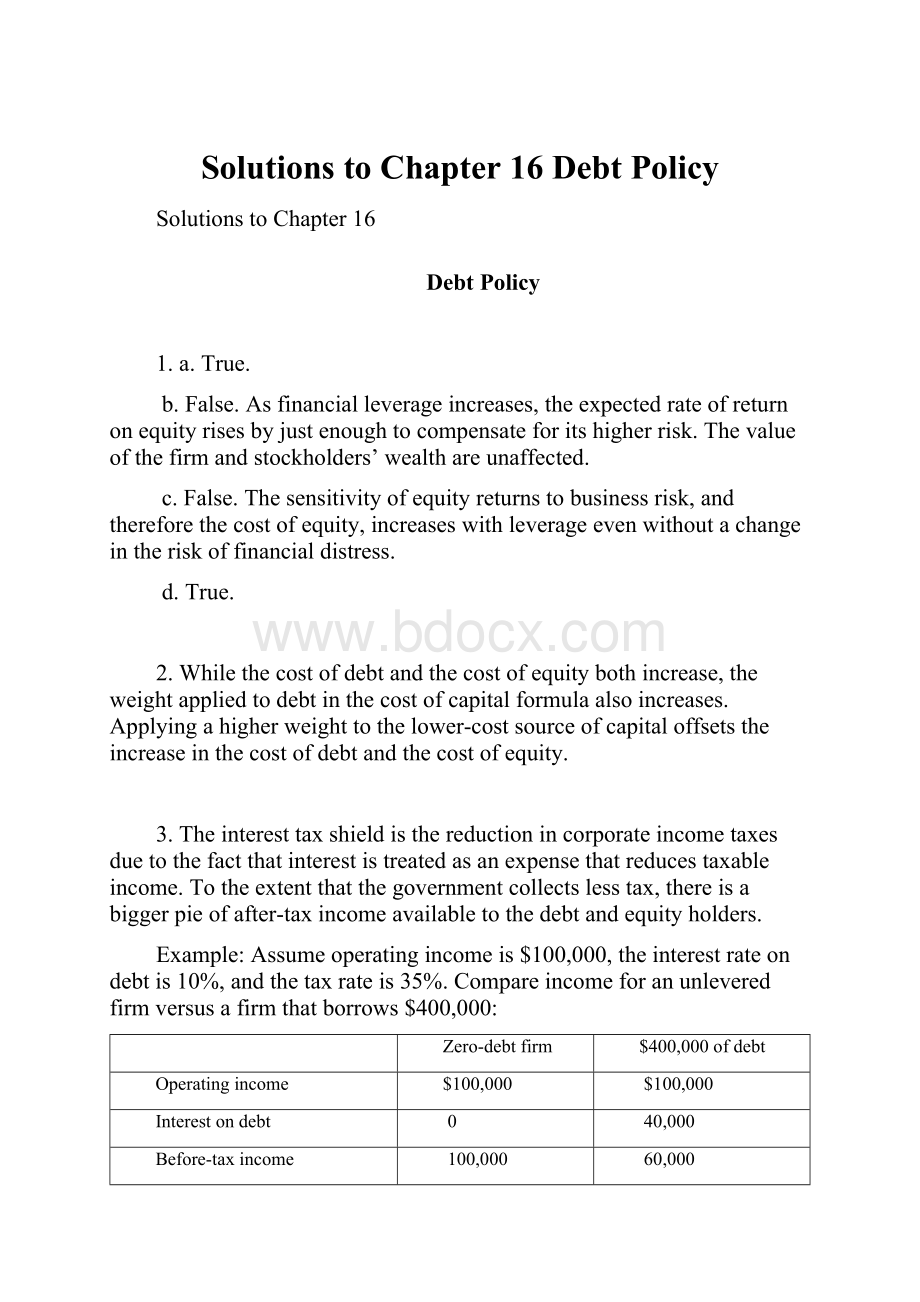Solutions to Chapter 16 Debt Policy.docx
《Solutions to Chapter 16 Debt Policy.docx》由会员分享,可在线阅读,更多相关《Solutions to Chapter 16 Debt Policy.docx(22页珍藏版)》请在冰豆网上搜索。

SolutionstoChapter16DebtPolicy
SolutionstoChapter16
DebtPolicy
1.a.True.
b.False.Asfinancialleverageincreases,theexpectedrateofreturnonequityrisesbyjustenoughtocompensateforitshigherrisk.Thevalueofthefirmandstockholders’wealthareunaffected.
c.False.Thesensitivityofequityreturnstobusinessrisk,andthereforethecostofequity,increaseswithleverageevenwithoutachangeintheriskoffinancialdistress.
d.True.
2.Whilethecostofdebtandthecostofequitybothincrease,theweightappliedtodebtinthecostofcapitalformulaalsoincreases.Applyingahigherweighttothelower-costsourceofcapitaloffsetstheincreaseinthecostofdebtandthecostofequity.
3.Theinteresttaxshieldisthereductionincorporateincometaxesduetothefactthatinterestistreatedasanexpensethatreducestaxableincome.Totheextentthatthegovernmentcollectslesstax,thereisabiggerpieofafter-taxincomeavailabletothedebtandequityholders.
Example:
Assumeoperatingincomeis$100,000,theinterestrateondebtis10%,andthetaxrateis35%.Compareincomeforanunleveredfirmversusafirmthatborrows$400,000:
Zero-debtfirm
$400,000ofdebt
Operatingincome
$100,000
$100,000
Interestondebt
0
40,000
Before-taxincome
100,000
60,000
Taxat35%
35,000
21,000
After-taxincome
65,000
39,000
Sumofdebtinterestplus
after-taxincome
$65,000
$79,000
Thecombineddebtinterestplusequityincomeishigherfortheleveredfirm.Thedifferenceequals$14,000,whichisalsothedifferenceintaxespaidbythetwofirms.
4.PV(Taxshield)=
5.a.False.Inliquidation,equityholdersgenerallyreceivenothing.Therefore,theyhavenothingtoloseinareorganization,whichallowsequityholders(andjuniorcreditors)to“playfortime,”hopingforareversaloffortunes.Ifthefirmisultimatelyliquidated,equityholdersmaystillreceivenothing,buttheyhavenotlostanythingeither.
b.True.
c.False.Claimsforpaymentofexpensesincurredafterthebankruptcyfilingreceivefirstpriority,followedbyemployeeclaimsforwagesandbenefits.IRSclaims(alongwithsomeclaimsfordebtsowedtogovernmentagencies)arenextinline.
d.True.
e.False.Ifthefirmisliquidated,tax-losscarry-forwardsdisappear.Inareorganization,thenewentityisentitledtoanytax-losscarry-forwardsoftheoldfirm.
6.Thetradeofftheoryofcapitalstructureholdsthattheoptimaldebtratioisdeterminedbystrikingabalancebetweentheadvantagesanddisadvantagesofdebtfinancing.Theadvantageofdebtfinancingistheinteresttaxshield.Thedisadvantagesarethevariouscostsoffinancialdistress.Asleverageincreases,themarginaltaxshieldfromeachdollarofadditionalborrowingfalls.Thisisaconsequenceoftheincreasingprobabilitythat,withhigherinterestexpense,thefirmwillnothavepositivetaxableincomeandthereforewillnotpaytaxes.Atthesametime,theexpectedcostsoffinancialdistressincreasewithleverage.Asleverageincreases,themarginalcostoffinancialdistresseventuallyoutweighstheinteresttaxshield.Attheoptimaldebtratio,theincreaseinthepresentvalueoftaxsavingsfromadditionalborrowingisexactlyoffsetbyincreasesinthepresentvalueofthecostsoffinancialdistress.
7.Directcostsofbankruptcysuchaslegaloradministrativecosts
Indirectcostsduetotheproblemsencounteredwhenmanagingafirminbankruptcyproceedings(e.g.,interferencebycreditorsordifficultiesbuyingsuppliesoncredit)
Poorinvestmentdecisionsresultingfromconflictsofinterestbetweencreditorsandstockholders.
8.Thepeckingordertheorystatesthatfirmsprefertoraisefundsthroughinternalfinance,andifexternalfinanceisrequired,thattheypreferdebttoequityissues.Thispreference–orpecking–orderresultsfromthefactthatinvestorsmayinterpretsecurityissues–equityissuesinparticular–asasignalthatmanagersthinkthefirmiscurrentlyovervaluedbythemarket;therefore,investorswillreducetheirvaluationofthefirminresponsetonewsofastockissue.
Ifthepeckingordertheoryiscorrect,wewouldexpectfirmswiththehighestdebtratiostobethosewithlowprofits,becauseinternalfinanceislessavailabletothesefirms.
9.Financialslackreferstoafirm’saccesstocash,marketablesecurities,bankfinancing,ordebtfinancing.Financialslackisvaluablebecauseitmeansfinancingwillbequicklyavailabletotakeadvantageofpositive-NPVinvestmentopportunities.
Toomuchfinancialslackcanbedetrimentalifitallowsmanagerstotakeiteasy,toempirebuild,ortouseexcesscashontheirownperquisites.
10.Numberofshares=75,000
Pricepershare=$10
Marketvalueofshares=$750,000
Marketvalueofdebt=$250,000
StateoftheEconomy
Slump
Normal
Boom
Operatingincome
$75,000
$125,000
$175,000
Interest
$25,000
$25,000
$25,000
Equityearnings
$50,000
$100,000
$150,000
Earningspershare
$0.667
$1.333
$2.000
Returnonshares
6.67%
13.33%
20.00%
11.Theinvestorcansellone-fourthofherholdingsinthefirm,andtheninvesttheproceedsindebt.Supposeshehas$10,000currentlyinvestedinthefirm.Shecouldsell$2,500worthofshares,usingtheproceedstobuybondsyielding10%.Thereturnonherportfolioinanyeconomicscenariois:
StateoftheEconomy
Slump
Normal
Boom
ReturnonShares
6.67%
13.33%
20.00%
ReturnonDebt
10.00%
10.00%
10.00%
PortfolioReturn*
7.50%
12.50%
17.50%
*PortfolioReturn=(0.25returnondebt)+(0.75returnonshares)
Theportfolioreturnispreciselythesameasitwaswhenthe$10,000wasinvestedintheunleveredfirm.
12.Shareprice=$10
Withnoleverage,thereare100,000sharesoutstanding:
Expectedearningspershare=
P/E=$10/$1.25=8
Withleverage,thereare75,000sharesoutstanding:
Expectedearningspershare=
P/E=$10/$1.333=7.5
P/Edecreasesbecausetheequityisnowriskier.Althoughearningspershareareexpectedtorisefrom$1.25to$1.333,thevalueofeachshareofequityisnohigher.Theincreaseinriskoffsetstheincreaseinexpectedearnings.
13.After-taxincomeforall-equityfirm:
StateoftheEconomy
Slump
Normal
Boom
Operatingincome
$75,000
$125,000
$175,000
Taxat35%
$26,250
$43,750
$61,250
After-taxincome
$48,750
$81,250
$113,750
After-taxincomeassuming$250,000ofdebtfinancing:
StateoftheEconomy
Slump
Normal
Boom
Operatingincome
$75,000
$125,000
$175,000
Debtinterestat10%
25,000
25,000
25,000
Before-taxincome
50,000
100,000
150,000
Taxat35%
17,500
35,000
52,500
After-taxincome
32,500
65,000
97,500
Combineddebt&equityincome
(debtinterest+after-taxincome)
57,500
90,000
122,500
After-taxincome(all-equitycase)
$48,750
$81,250
$113,750
Differenceinincome
$8,750
$8,750
$8,750
Inallstatesoftheeconomy,thedifferenceintotalincometoallsecurityholdersis$8,750.Thisisexactlyequaltothetaxshieldfromdebt:
TcInterestexpense=0.35$25,000=$8,750
14.Expectedreturnonassetsis:
rassets=(0.0830/100)+(0.1670/100)=0.136=13.6%
Thenewreturnonequityis:
requity=rassets+[D/E(rassets–rdebt)]
=0.136+[20/80(0.136–0.08)]=0.15=15%
15.a.Marketvalueoffirmis:
$10010,000=$1,000,000
Withthelow-debtplan,equityfallsby$200,000,so:
D/E=$200,000/$800,000=0.25
8,000sharesremainoutstanding.
Withthehigh-debtplan,equityfallsby$400,000,so:
D/E=$400,000/$600,000=0.67
6,000sharesremainoutstanding.
b.Low-debtplan
EBIT$90,000$130,000
Interest20,00020,000
EquityEarnings70,000110,000
EPS[Earnings/8,000]$8.75$13.75
ExpectedEPS=($8.75+$13.75)/2=$11.25
High-debtplan
EBIT$90,000$130,000
Interest40,00040,000
EquityEarnings50,00090,000
EPS[Earnings/6000]$8.33$15.00
ExpectedEPS=($8.33+$15)/2=$11.67
Althoughthehigh-debtplanresultsinhigherexpectedEPS,itisnotnecessarilypreferablebecauseitalsoentailsgreaterrisk.ThehigherriskshowsupinthefactthatEPSforthehigh-debtplanislowerthanEPSforthelow-debtplanwhenEBITislow,butEPSforthehigh-debtplanishigherwhenEBITishigher.
c.Low-debtplanHigh-debtplan
EBIT$100,000$100,000
Interest20,00040,000
EquityEarnings80,00060,000
EPS$10.00$10.00
EPSisthesameforbothplansbecauseEBITis10%ofassetswhichisequaltotheratethefirmpaysonitsdebt.Whenrassets=rdebt,EPSisunaffectedbyleverage.
16.Currently,withnooutstandingdebt:
equity=1.0
Therefore:
assets=1.0
Also:
requity=10%rassets=10%
Finally:
rdebt=5%
Thefirmplanstorefinance,resultinginadebt-to-equityratioof1.0,anddebt-to-valueratio:
debt/(debt+equity)=0.5
a.(equity0.5)+(debt0.5)=assets=1
(equity0.5)+0=1equity=1/0.5=2.0
b.requity=rassets=10%
riskpremium=requity–rdebt=10%–5%=5%
(Notethatthedebtisrisk-free.)
c.requity=rassets+[D/E(rassets–rdebt)]=10%+[1(10%–5%)]=15%
riskpremium=requity–rdebt=15%–5%=10%
d.5%
e.rassets=(0.5requity)+(0.5rdebt)=(0.515%)+(0.55%)=10%
Thisisunchanged.
f.Supposetotalequitybeforetherefinancingwas$1,000.Thenexpectedearningswere10%of$1000,or$100.Aftertherefinancing,therewillbe$500ofdebtand$500ofequity,sointerestexpensewillbe$25.Therefore,earningsfallfrom$100to$75,butthenumberofsharesisnowonlyhalfaslarge.Therefore,EPSincreasesby50%:
g